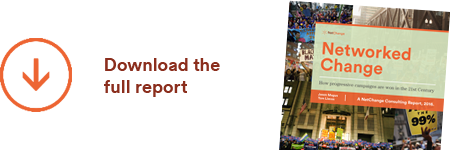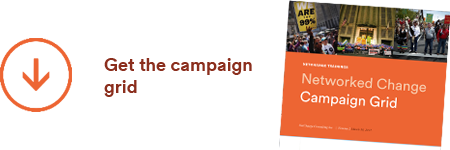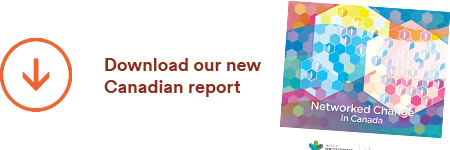What is a netcentric campaign?
There are few progressive issues we can look back at over the last 10 years that show measurable and sustained progress. This fact alone should greatly humble NGO campaigners, consultants, and funders alike. Yet at the same time there have been some incredible successes – from the growth of Avaaz to 12M+ members, to the Arab Spring, Obama’s election in 2008, and the early days of the Occupy Wall Street movement, that may point to the power of new, networked models of campaigns showing a new way.
The common thread among initiatives that are struggling is centralized leadership in strongly hierarchical, highly independent, professionalized organizations. Many recent growth leaders take more of a network-centric approach to campaigning, with more flat, nimble structures, strong reliance on partnerships, and importantly people-powered engagement models at their core.
The 7 patterns of nonprofit digital teams
This is the third in a three part series on digital teams for nonprofits published in the Stanford Social Innovation Review. You can download the benchmark report referenced in the article below for free.
We have been planning and building websites for social change institutions for nearly two decades, and over that time have worked with some of the most well-known social brands in the world, as well as hundreds of lesser-known groups. What we’ve seen across all organizations, regardless of size, is that digital teams—their structure, leadership, and how they are affected by the culture of the institutions where they work—are the biggest predictor of online effectiveness. Without well-structured teams, strong leadership, appropriate skills, and an aligned internal culture, you simply can’t do all the great things you want to do online, sustainably over the long term.
This summer we set out to learn more about the state of digital teams in the nonprofit sector. Finding few resources on the topic, we decided to create the world’s first digital team structure benchmark for the nonprofit sector. We did this in order to start a conversation about the importance of building better teams and the importance of investing in them.
Senior online leaders from 67 nonprofit organizations contributed to the final report. Here are seven of the most important patterns we observed:
Four models for managing digital
So what’s the best way to manage digital at your organization? While no two organizations look the same, there are typically four models we’ve seen in our consulting experience: informal, centralized, independent, and hybrid. The first is typically a legacy of a poorly managed institution, the second and third get closer to what we think institutions need to sustain cultures of innovation, but it is really the fourth that can most consistently produce the integrated, customer-centric digital experience across all channels that is the holy grail of excellence in today’s world.
Here’s a look at the four models:
This is the second in a three part series published in the Stanford Social Innovation Review.
The 5 dysfunctions of a digital team
The digital function is increasing in importance in nearly all institutions today, yet few are actually managing it in an effective way. While there is no one right way to manage digital, the way most institutions structure their digital teams greatly limits the outcomes they seek, because every innovation they want to do online will be limited by their own internal capacity to dream, execute, and sustain it over time.
This is the first in a three part series on digital team structures published in the Stanford Social Innovation Review.
What if you wrote the perfect strategy and no one read it?
Come on, be honest, this has happened to you, right? You’re all fired up after a meeting because you’ve come up with the perfect strategy to help your department – and maybe the whole organization – move forward in a big way. You write it up, deliver it to your boss, and…nothing happens. Your boss doesn’t think it’s so great and is so focused on other things she won’t really tell you why. Or she tells you to work it out with an underling, who shows no interest in helping “you” succeed. Maybe she brought it up at a meeting and it got shot down by one of her peers. Maybe she switched jobs, and the new gal isn’t so interested in ideas from the “old regime”.
It’s sad how many great, thoughtful ideas for change end up D.O.A. like this, but this is kind of the way of life inside many institutions isn’t it?
Web of Change – leadership for a networked world
Next week we are very pleased to co-host the 11th annual Web of Change conference at Hollyhock. When we founded it back in 2000 we never could have imagined how vibrant and relevant it would still be today.
You see Web of Change has evolved to become so much more than merely a conference. Of all the projects I’ve been involved with, this is the closest to a real, generative community – with both online and real world touchpoints – that I’ve come across.
Add it up! How the US environmental movement can start to act like one
It’s been heartening watching the environmental NGO community finally take up arms against US President Obama’s weak environmental record this past week. The bold leadership with clear, direct statements has been inspiring, with their threats to pull their support and the positive response from their supporters to do so marking a rare movement wide high point.
Unfortunately, these groups still act like isolated individual brands and not movement allies, which I think greatly misses the impact of their efforts. In emails, on the web, and to the media, they talk to their supporters like they are the only ones out there doing this heroic work. They only show public support response numbers from their own supporters. They never mention or even allude to the fact that nearly every green group is engaged in the same fight at the same time!
Why we stopped building websites (and why that matters to you)
Last month we launched the last website Communicopia will build. Why have we stopped making sites after 18 years and close to 1,000 projects? And what does this have to do with how you hire vendors for your digital projects? Read on.
Way back in the day, during the .com boom years, a web agency was expected to do everything for you. Come up with a great strategic approach. Design a clear and lasting content structure. Make a killer design. And tie it all together with a back-end that did amazing things. Since those days, the web world has gotten both simpler, and more complex, and projects have therefore gotten both cheaper at the low end and more expensive at the high end.
The World Bank opens up, how about you?
It isn’t every day you open your favourite newspaper and see an article that validates absolutely everything you’ve been prattling on about for the last few years. But there it was, on the front page of the business section in last Sunday’s New York Times: “World Bank Opens its Treasure Chest of Data”, and it’s the most powerful case study of using digital as a catalyst to renew a tired institution that I’ve come across in years.
You see it wasn’t merely the story about another government group embracing open data, which, as exciting as that is, is only a policy wedge to get at the juicier stuff. This was a story of an institution in transition, being humbled by how difficult it is to make change in this complex, interconnected world, and realizing the limits of the “we’re big enough to go it alone” approach it’s taken for 67 years.
Social media builds community, but not always
My friend and colleague Alex Samuel has written “the soul of the Internet can be shaped by how we individually engage with it. [We get to choose] whether the Internet alienates and isolates us; or connects and enriches us.” We are still very much shaping this emerging tool today with our behaviours, and the way we do so does not always lead to more community and connectedness.
The shameful Stanley Cup riots in my beautiful city last week show a real time example. People’s behaviours during and after the riots have both strengthened and diminished our sense of trust and community. If you’re only watching mainstream media you might miss the good that happened, but each pattern of behaviour left a unique digital signature online we can study.
Culture change through digital projects – 8 steps
One of my wiser clients once told me “Culture eats strategy. Every time”. If you’ve worked in this field for a while now you see how many change projects fail to achieve their (admittedly often too high) expectations. The idea of embracing change sounds great on paper, but as any therapist will tell you, it’s extremely difficult to break away from years of patterned behaviour. Add all those individual pattens into a structured system, and you’ve got a big barrier standing in the way of innovation.
My experience from leading digital change projects for 15 years is that if you don’t use the catalyst of a digital project to shift the culture of your institution towards a more innovative and responsive model, you’re really just building a website.
Designing for engagement
Too often in the digital world we see websites and campaigns from worthy causes fail. They fail to reach intended audiences, fail to go viral, fail to make a real difference in the world. A smart campaign concept or eye-catching design might pique people's interest,...
Creating network effects with collaborative campaigns
This week’s Canadian election was shaping up as a once in a generation game-changer. Some surprisingly creative social media campaigns – driven by a few smart new players – were making an impact on the nightly news and with large swaths of voters, especially youth. I decided to reach out to the leaders of these groups to see if we could find ways to increase their impact.
The pitch was to collaborate publicly and behind the scenes to show up as a united and organized movement. And to create a powerful content network through shared key messaging and activities that would drive more traffic to everyone’s sites and, most importantly, the voting booth.
Be like the web part 2: Network organization structures
Earlier I wrote how many of today’s most successful digital campaigns are grown from organizations who are thinking differently, and not just with their online campaigns. These “network organizations” operate in fundamentally different ways from traditional centralized organizations, and, with relatively few resources, are growing faster and having an outsized impact on our world.
What’s a network organization? From the business world, think Facebook, Google, & Groupon. In NGO’s, think Avaaz, MoveOn, & MomsRising. And what about Wikileaks, Sarah Palin, and the Obama presidential campaign? All have attributes of organizations with network principles baked into their core.
6 principles of transformative digital campaigns
In the last few weeks I’ve had calls from a high profile multi-city concert to grow the global women’s movement, an international network of freedom of expression activists who need to re-invent their organization, and a big international NGO that wants to “network their whole organization” so they can do more with the same number of people.
For each of these ambitious visions, digital lies at the core of their plans. It’s a way to land the conceptual changes they want in a practical way. The challenge is to design campaigns or new organizational structures that don’t just graft new tools onto old, linear models. If you want to know how that works, tell me how well your organization collaborates internally, or point to the transformative cultural changes you’ve pulled off lately. .
Not dead yet: Blogs still the backbone
We’ve heard a lot of noise lately about blogs being a dying breed, with people’s attention and effort being pulled towards smaller snippets of content in social networks. While that’s certainly happening, I believe blogs are still a critical and under-utilized tool for organizations to share expertise, support cause goals, and grow their businesses. In fact, they are the backbone of a strong multi-channel engagement strategy.
A recent Pew research study shows that, far from shrinking, blog use among adults has grown by an amazing 27% in only the last 2 years.
Nothing But Nets helps EVERY family in Central African Republic
Congratulations are in order for the UN Foundation for reaching another impressive milestone in their highly successful global effort against malaria.
Last week the Nothing But Nets campaign met its goal of giving malaria-preventing bed nets to every family in the Central African Republic. In total they supplied about 837,000 nets with a value of more than $1.25 million.
Fresh Start: 5 resolutions for your digital program in 2011
For most of us the holidays bring much needed downtime from our busy lives, offering time for reflection, visioning, and planning for the road ahead. The big stories last year will no doubt continue in 2011: massive change and uncertainty is the norm, power continues to shift from big, old, closed institutions (even countries) to newer and more nimble ones, and collaboration, the web and networks are enabling these structural shifts like never before.
Isn’t it time to take a fresh look at your organization's digital program to put you on the right side of these historic shifts?









